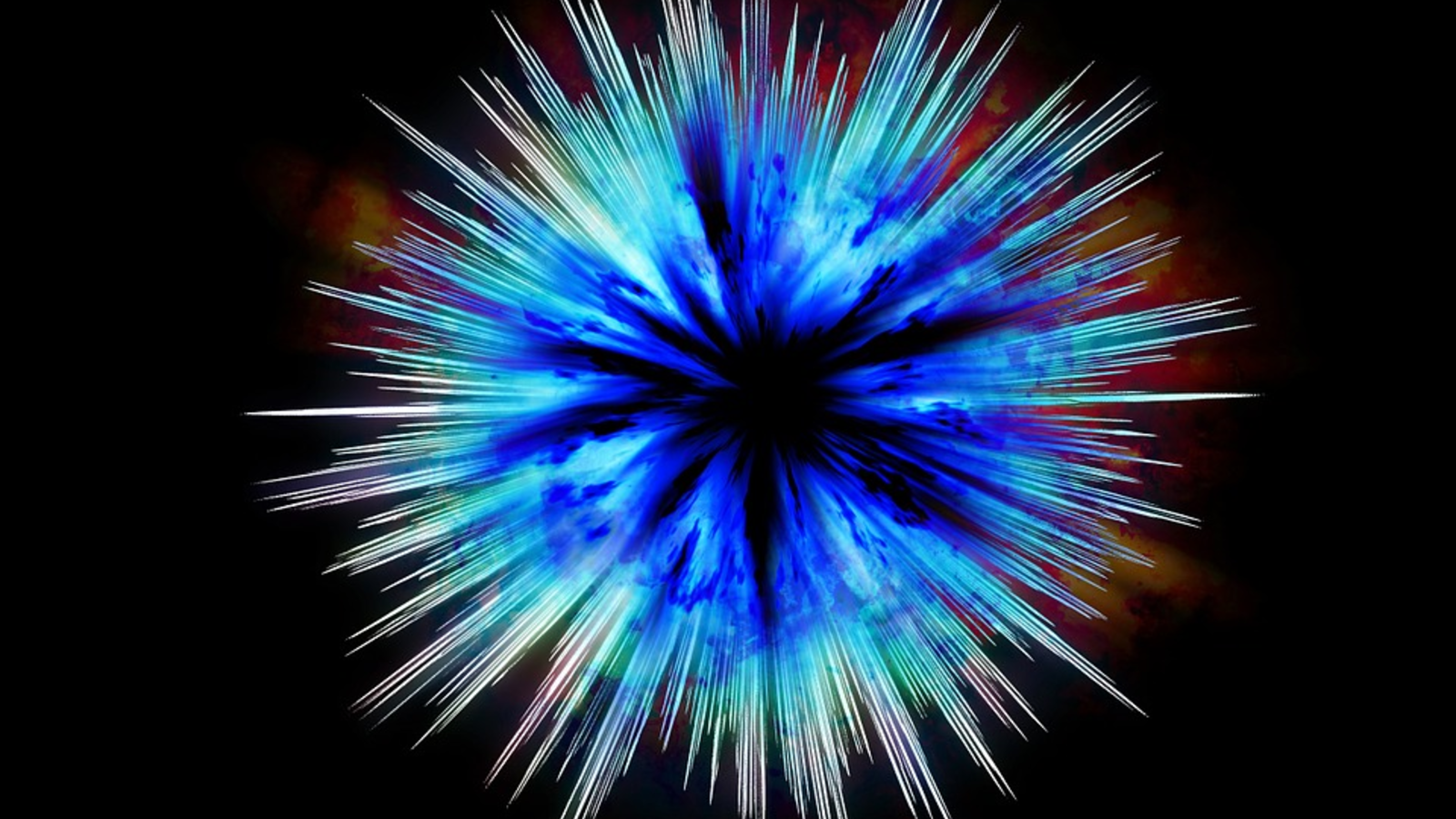Current Scientific Theory
According to modern physics, the universe sprang into existence 15 billion years ago in the Big Bang. During the first fragment of a second, the universe expanded from a singularity–an infinitely small, dense point–into a primeval fireball, a chaotic storm of energy out of which the first fundamental particles began to form.
After three minutes, protons and neutrons began sticking together, forming hydrogen and helium nuclei, but only after another 300,000 years had the universe cooled enough to allow these nuclei to bind with electrons, creating the first atoms. As the atoms formed, photons were released and electromagnetic radiation was able to travel for the first time, flooding the previously opaque universe with light.
As a result of gravity, atoms began falling together and forming clumps. It took 300 million years for this process to give birth to the first stars and galaxies, and another nine billion years before our solar system came into existence. The earth was formed around 4.5 billion years ago, and the earliest fossil evidence of life on our planet is dated to a billion years (one aeon) later.
Contrasting Biblical Account
The Bible presents a radically different account of the beginning of the world. The first chapter of Genesis describes what seems to be a flat earth, geocentric story in which God takes six days to create–in the following order–light and darkness, the sky, land and sea, plants, the sun, moon and stars, marine life, birds, land animals and, finally, the first human beings. Calculations based on later biblical genealogies indicate that this process took place less than six thousand years ago.
With your help, My Jewish Learning can provide endless opportunities for learning, connection and discovery.
For modern Jews, this discrepancy poses a problem. The Torah, traditionally held to be an accurate record of divine revelation, flat out denies the best of contemporary scientific research. Does this necessitate making a choice between tradition and science, or is it possible to negotiate the contradiction?
Many modern Jews either dismiss the traditional creation story, interpreting the opening chapter of Genesis as myth or metaphor, or reject the scientific account as incompatible with the incontestable truth of Torah. Others prefer to compartmentalize, utilizing a kind of doublethink to apply scientific narratives in some areas of their lives and religious ones in others. Making the effort to synthesize Genesis and science is only one option among many, and far from the simplest.
Drawing Connections
In one way, modern physics has made the challenge easier. Medieval thinkers were forced to grapple with the tension between the Torah’s creation story and Aristotle’s notion that rather than having been created in time, the world had always existed. Today there is no dispute that the universe came into being at some point in the past. This apparent commonality has provided motivation for some writers to take up the challenge of proving that modern physics merely points to the timeless truths which are clearly described in the book of Genesis.
One such writer is Nathan Aviezer, Professor of Physics at Israel’s modern-Orthodox Bar Ilan University. The thesis of Aviezer’s book, In the Beginning… Biblical Creation and Science, is that contrary to common misconceptions, cutting edge scientific developments have actually brought physics into closer harmony with Genesis than ever before.
Aviezer analyzes the biblical days of creation one at a time, matching up the events described with elements of the scientific theory of the universe’s origins. But first he makes one proviso upon which the rest of his hypothesis depends: the “days” referred to in Genesis should not be understood as 24 hour periods but as important stages in the development of the world. This interpretation is drawn from many traditional Bible commentaries, based on the fact that before the creation of the sun on the fourth day, the terms day and night could not possibly have carried their commonplace meanings.
Filling the Gaps
Aviezer’s premise is that the Big Bang theory confirms the first verse of the Bible, but that in contrast to modern physics, which by its own admission is unable to discern what happened before the Big Bang, Genesis clearly describes the cause: “In the beginning, God created the heavens and the earth.” God’s command “let there be light” refers to the appearance of the primeval fireball, containing all the matter and energy of the present-day universe, and the chaos–tohu va-vohu–described in the Bible matches the random and chaotic condition of the universe in its initial state. Finally, “God separated the light from the darkness” refers to the formation of atoms, the consequent freeing of photons and the flooding of the universe with electromagnetic radiation.
Aviezer analyzes the subsequent days of creation along the same lines, generally interpreting the Bible in line with scientific knowledge, sometimes having to depart from the plain meaning of the text in order to deal with problems such as the fact that according to Genesis, the sun was created on day four, after the emergence of plant life on earth.
The argument of In the Beginning is less straightforwardly scientific than it seems. Aviezer is at pains to emphasize the statistical improbability of those details of the universe’s development which laid the groundwork for the appearance of life and the ultimate evolution of human beings, arguing that these processes could not have taken place in the absence of purposeful (divine) intervention. But this is, of course, a theological argument, not a scientific one.
Although many physicists agree that scientific knowledge cannot explain everything, being limited to the period beginning a split second after the Big Bang, evolutionary biology is affected by no such sense of modesty. In his book The Blind Watchmaker, for example, well known atheist biologist Richard Dawkins robustly dispenses with Aviezer’s claims as to the improbability of life and advances the argument that the theory of evolution can explain the origin of life with no need for recourse to supernatural interference.
If Aviezer begins by suggesting that the Bible can be read in such a way as to bring it into line with scientific knowledge, a statement at the end of his book implies that in the event of a clash between the two systems, religious faith must take priority: “If I were to find that traditional Judaism appeared to be inconsistent with certain aspects of modern science, this would in no way weaken my [religious] commitment.”
Radical Interpretation
The case carefully advanced by Aviezer hit the headlines with the publication of Gerald Schroeder’s bestselling Genesis and the Big Bang, a more radical book in terms of both style and content. Since Schroeder advances essentially the same ideas as Aviezer, I’ll focus on two key differences between the writers’ arguments.
First: Aviezer was content to interpret the “days” of creation figuratively. Not so Schroeder. For him, Genesis is a literal account of the scientifically established process of creation. He resolves the contradiction between six days and 15 billion years by invoking Einstein’s theory of relativity, which asserts that rather than being an absolute value, the flow of time is influenced by motion and gravitational force.
Time being relative, six days in one frame of reference could well be equivalent to 15 billion years in another. Since there was no possibility of objectively measuring the time involved in the creation process, Schroeder draws the audacious conclusion that six days represented the elapsed time from none other than God’s perspective.
This claim raises difficult religious questions. Since relativistic time dilation is a function of motion and gravity, are we to understand that these forces operate on God, in other words that God is part of the physical universe? It seems that in an attempt to extricate himself from an annoying textual problem (the discrepancy between the age of the universe according to Genesis and the Big Bang theory), Schroeder has opened the door on a much more significant theological one.
Second: Schroeder claims that people who think that Genesis clashes with modern physics have not read the Bible carefully enough–the Torah must be understood through study of the canonical commentaries: Onkelos, Rashi, Maimonides and Nahmanides. On the face of it, for example, the Bible contains no hint that the creation of the universe was a process of expansion from an initial singularity.
However, Nahmanides’ comment on Genesis 1:1 implies exactly that: “At the briefest instant following creation, all the matter of the universe was concentrated in a very small place, no larger than a grain of mustard…. From the initial concentration of this intangible substance in its minute location, the substance expanded, expanding the universe as it did so.” In Schroeder’s view, this kind of in-depth reading of the Torah will always tend to reveal the consonance between two sources of truth–revelation and science.
Weaknesses
Schroeder’s argument that physics and biblical scholarship are methodologically compatible is weakened, however, by his approach to Jewish texts. He reads the Bible through the lens of the rabbis, medieval commentators and kabbalah, assuming that their homiletical and midrashic perspectives are identical to the plain meaning of the original text.
However, it is difficult to characterize this approach as scientific when it ignores academic bible critics’ linguistic and archaeological contributions. In other words, Schroeder’s commitment to scientific methodology has a clear limit: he does not apply it to the study of Torah.
Schroeder’s attitude to religion itself is no less ambiguous. One of his arguments is that whereas once the facts about the universe’s origins could only be accessed via revelation, modern physics has given us the tools to confirm these facts. While medieval thinkers like Nahmanides reached their insights by means of faith, modern Jews are only able to grasp the truth of the Torah through recourse to science. If so, the true Genesis narrative has only been available to us since the Big Bang theory was substantiated in the 1960s.
By implying that the Torah’s deep insights cannot be accessed unless we have already discovered them by scientific means, Schroeder may, ironically, undermine his own position, making the Torah redundant as an independent source of truth.
Torah
Pronunced: TORE-uh, Origin: Hebrew, the Five Books of Moses.



